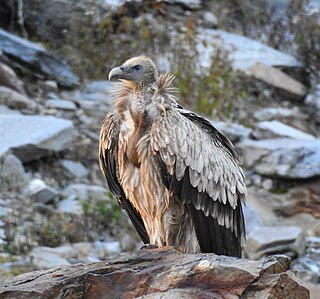
The Himalayan vulture or Himalayan griffon vulture is an Old World vulture native to the Himalayas and the adjoining Tibetan Plateau. It is one of the two largest Old World vultures and true raptors. It is listed as Near Threatened on the IUCN Red List. It is not to be confused with the Eurasian griffon vulture, which is a similar and sympatric species.

The rock dove, rock pigeon, or common pigeon is a member of the bird family Columbidae. In common usage, it is often simply referred to as the "pigeon", although this is the wild form of the bird; the pigeons most familiar to people are the domesticated form of the wild rock dove.

The stock dove or stock pigeon is a species of bird in the family Columbidae, the doves and pigeons. It is widely distributed in the western Palearctic.

The pigeon guillemot is a species of bird in the auk family, Alcidae. One of three species in the genus Cepphus, it is most closely related to the spectacled guillemot. There are five subspecies of the pigeon guillemot; all subspecies, when in breeding plumage, are dark brown with a black iridescent sheen and a distinctive wing patch broken by a brown-black wedge. Its non-breeding plumage has mottled grey and black upperparts and white underparts. The long bill is black, as are the claws. The legs, feet, and inside of the mouth are red. It closely resembles the black guillemot, which is slightly smaller and lacks the dark wing wedge present in the pigeon guillemot.

The trocaz pigeon, Madeira laurel pigeon or long-toed pigeon is a pigeon which is endemic to the island of Madeira, Portugal. It is a mainly grey bird with a pinkish breast; its silvery neck patch and lack of white wing markings distinguish it from its close relative and probable ancestor, the common wood pigeon. Its call is a characteristic six-note cooing, weaker and lower-pitched than that of the wood pigeon. Despite its bulky, long-tailed appearance, this pigeon has a fast, direct flight.

The russet sparrow, also called the cinnamon or cinnamon tree sparrow, is a passerine bird of the sparrow family Passeridae. A chunky little seed-eating bird with a thick bill, it has a body length of 14 to 15 cm (5.5–5.9 in). Its plumage is mainly warm rufous above and grey below. It exhibits sexual dimorphism, with the plumage of both sexes patterned similarly to that of the corresponding sex of house sparrow. Its vocalisations are sweet and musical chirps, which when strung together form a song.

The white-headed pigeon is a pigeon native to the east coast of Australia.
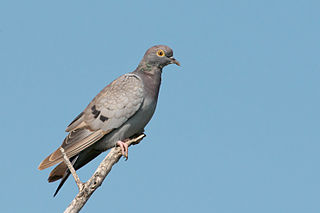
The yellow-eyed pigeon, pale-backed pigeon, yellow-eyed dove or yellow-eyed stock dove is a member of the family Columbidae. It breeds in southern Kazakhstan, Uzbekistan, Turkmenistan, Tajikistan, Kyrgyzstan, Afghanistan, north-east Iran and extreme north-west China. It winters in north-east Pakistan, Jammu and Kashmir and parts of Rajasthan. The bird has declined in numbers over the years, chiefly because of hunting, and it is listed as "vulnerable" by the International Union for Conservation of Nature.

The African olive pigeon or Rameron pigeon is a pigeon which is a resident breeding bird in much of eastern and southern Africa from Ethiopia to the Cape. Populations also are found in western Angola, southwestern Saudi Arabia and northern Yemen. It is locally common, although sizeable gaps in its distribution occur due to its habitat requirements.

The Nepal house martin is a non-migratory passerine of the swallow family Hirundinidae. Its two subspecies breed in the Himalayas from northwestern India through Nepal to Myanmar, northern Vietnam, and just into China. It occurs in river valleys and rugged wooded mountain ridges at heights between 1,000–4,000 m (3,300–13,100 ft) altitude, where it nests in colonies beneath overhangs on vertical cliffs, laying three or four white eggs in an enclosed mud nest.
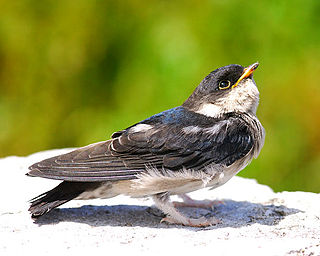
The Asian house martin is a migratory passerine bird of the swallow family Hirundinidae. It has mainly blue-black upperparts, other than its white rump, and has pale grey underparts. Its three subspecies breed in the Himalayas and in central and eastern Asia, and spend the winter lower in the mountains or in Southeast Asia. This species is locally abundant and is expanding northward in Siberia, so there are no concerns about its conservation status.
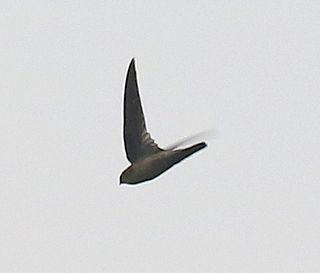
The Himalayan swiftlet is a small swift. It is a common colonial breeder in the Himalayas and Southeast Asia. Some populations are migratory.

The hill pigeon, eastern rock dove, or Turkestan hill dove is a species of bird in the family Columbidae.

The mountain imperial pigeon, also known as the maroon-backed imperial pigeon or Hodgson's imperial pigeon, is a species of bird in the pigeon and dove family with a wide range in southeastern Asia.
The grey-headed imperial pigeon is a species of bird in the family Columbidae. It is endemic to Sulawesi in Indonesia. Its natural habitats are subtropical or tropical moist lowland forests and subtropical or tropical moist montane forests.

Mountain pigeons are four species of birds in the genus Gymnophaps in the pigeon family Columbidae. They are found on islands in eastern Indonesia and Melanesia, where they inhabit hill and montane forest. Medium-sized pigeons with long tails and wings, they are 33–38.5 cm (13.0–15.2 in) long and weigh 259–385 g (9.1–13.6 oz). They mostly have dull grey, white, or chestnut-brown plumage, their most distinctive feature being bright red skin around the eyes. Males and females mostly look alike, but the Papuan and pale mountain pigeons show slight sexual dimorphism. Mountain pigeons are very social and are usually seen in flocks of 10–40 birds, although some species can form flocks of more than 100 individuals. They are generally quiet and do not make many vocalisations apart from a distinctive whooshing noise while leaving their high-altitude roosts to feed in the morning.
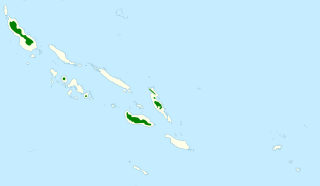
The pale mountain pigeon is a species of bird in the pigeon family Columbidae. It is endemic to the Solomon Islands archipelago, where it inhabits old-growth and secondary montane forest. It is a medium-size pigeon with an average length of 38 cm (15 in) and a weight of 310–385 g (10.9–13.6 oz). The head and neck are whitish-grey, the belly and lower breast are buffy-pink, and the vent and undertail coverts are pale grey. The upperparts are smoky-grey with darker fringes on the mantle and wing coverts. Both sexes look similar, but there can be large variation in individual appearance.

The thick-billed ground pigeon, also known as the jungle pigeon or the slaty/grey ground pigeon, is a species of bird in the family Columbidae. It is monotypic within the genus Trugon. Native to New Guinea, its natural habitat is moist tropical lowland forest.

The Buru mountain pigeon, formerly also long-tailed mountain pigeon is a species of bird in the pigeon family Columbidae. It is endemic to Indonesia and inhabits montane forest and disturbed lowland forest on Buru. It was formerly considered to be conspecific with the Seram mountain pigeon. It is a medium-sized pigeon 33–38.5 cm (13.0–15.2 in) long, and has a blue-grey crown and neck, darker slate-grey upperparts, and a white to pale buff-pink throat and breast that becomes buff-pink towards the belly. The species is slightly sexually dimorphic, with females being smaller and having more dark red on the breast.

The Seram mountain pigeon is a species of bird in the pigeon family Columbidae that is endemic to the island of Seram in Indonesia, where it inhabits hill forest. It was long considered to be a subspecies of the Buru mountain pigeon, but was split on the basis of differences in appearance. It is a medium-sized pigeon with a buff-pink face and breast, wine-pink underparts, a grey nape, crown, back of neck, and thighs, and dark chestnut belly and underside of the tail.























